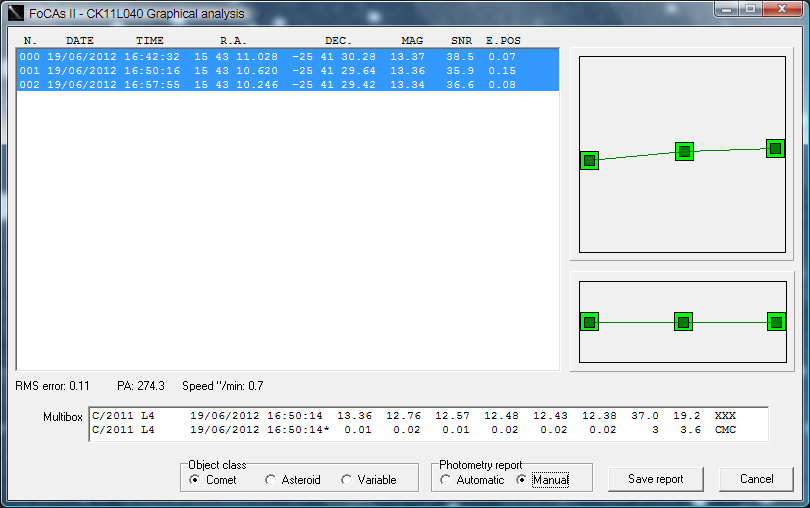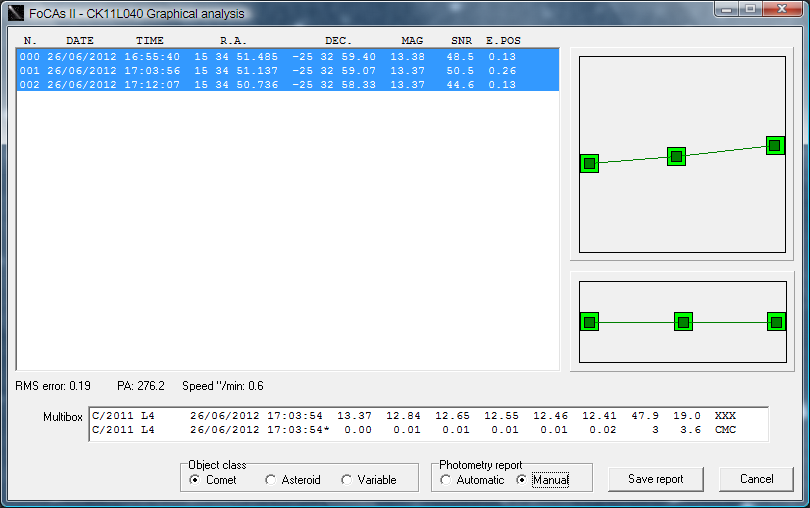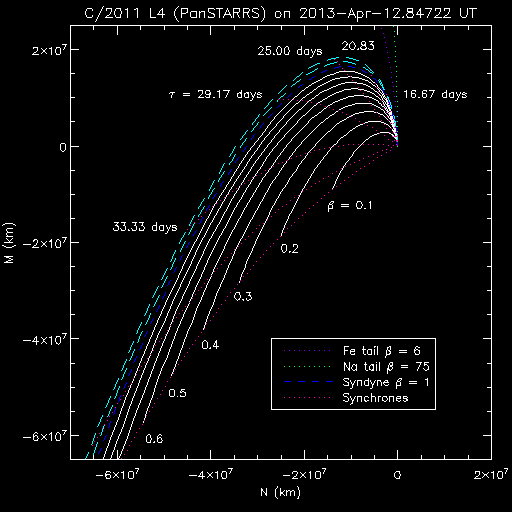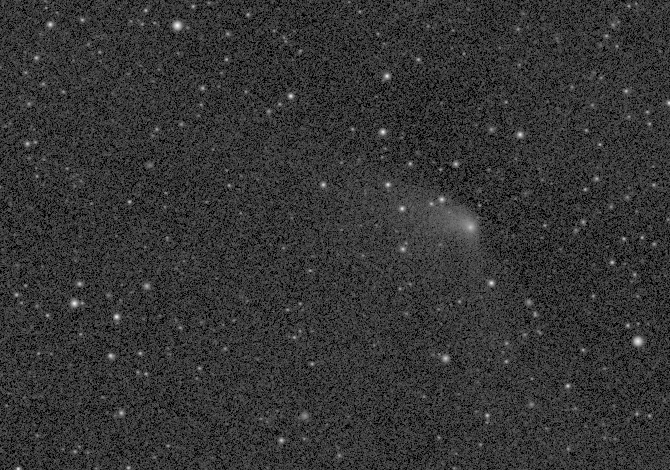|
|
| Mouse-over to browse the image in 4-color sequels version with L-S filtered one attached. |
2012/06/13 2012/06/19 2012/06/26 2013/04/12 2013/04/30 2013/05/22 2013/05/23 2013/05/31
|
|
| Mouse-over to browse the image in 4-color sequels version with L-S filtered one attached. |
MPC observation computed with Astrometrica using both UCAC-3 and CMC-14 star catalogs -- the former for astrometric reduction and the latter for photometric work:

I employed IDL to fit the magnitude data, so as to work out the infinite aperture magnitude. For brevity, I did not convert the magnitude enclosed by square boxes to apertures, as I do not think the difference will be large. The model funciton I use is
$ m\left ( r \right )=m_\infty -2.5\log \left [ 1-\exp \left ( -\frac{r}{\rho} \right ) \right ] $ (1),
where $ r $ is the radius of some aperture, $\rho $ is the apparent radius of the coma, and $ m_\infty $ is the magnitude obtained by an infinite aperture. During the fitting, I found that the measured diameter 21".6 as written in the photograph was a bit smaller than the reality if the model validates. A diameter of 29".1 for the coma accurately describes magnitudes in different apertures. It may well be that the exposure was insufficiently long to reveal the outer and much fainter fraction of the coma. Now I can obtain $m_\infty = 12.62$.
The activity of the comet is predicted to culminate due around March 2012, as its brightness may then reach $ -1^m $, thereby becoming another spectacle, providing that the current tendency keeps and no disintegration occurs. So let's stay tune!
Copyright @ Man-To Hui 2012/06/14
|
|
| Mouse-over to browse the image in 4-color sequels version with L-S filtered one attached. The comet appears more condensed than during our last observation. |
MPC observation computed with Astrometrica using both UCAC-3 and CMC-14 star catalogs -- the former for astrometric reduction and the latter for photometric work:
The radial profile plotted by PhAst.
Note that the measured stacked image had been cropped before fed into the software. The FWHM of the coma is equivalent to 7.45 arcsec.

I again used IDL to fit the magnitude data for probing the infinite aperture magnitude. The model funciton is the one given by equation (1).
Yet again during the fitting, the measured diameter 32" was found to be somewhat smaller than the reality if the model is in accordance. Instead, a diameter of 39".5 for the coma accurately describes magnitudes in different apertures. Perhaps the exposure was again insufficiently long to reveal the outer and much fainter fraction of the coma. If the coma really achieves the estimated aforementioned size, $m_\infty = 12.32$ is attained.
It does seem that the comet is keeping in the tendency of steady brightening, which is definitely a good sign. Yet as a fragile "dirty snowball", it risks disintegrating all the time on the way towards its perihelion and even during retrograding postperihelion until a large heliocentric distance is reached. We do hope it will become a fabulous comet around its perihelion. May God bless it!
Copyright @ Man-To Hui 2012/06/20
|
|
| Mouse-over to browse the image in 4-color sequels version with L-S filtered one attached. Note the delicate structure within the coma in the L-S filter-processed image, perhaps artefact? |
MPC observation computed with Astrometrica using both UCAC-3 and CMC-14 star catalogs -- the former for astrometric reduction and the latter for photometric work:
The radial profile plotted by PhAst.
Note that the measured stacked image had been cropped before fed into the software, and therefore the pixel coordinates of the coma is nearly meaningless. The FWHM of the coma is equivalent to 6.83 arcsec.

IDL was used for magnitude data fitting to obtain the infinite aperture magnitude. The model funciton is the one given by equation (1).
The measured diameter 31" was yet again found to be smaller than the to-be-fitted value, which is estimated to be 39".4 for best description, if the model is accurately valid. These yields $m_\infty = 12.37$, slightly dimmer than the value obtained during last observation.
Despite fainter $m_\infty$, it could not be firmly state that the cometary activity is reduced. For one thing the data is far from insufficiently abundunce. For another the phase angle effect may play an unoblivious role as well when the surge in brightness of the coma is only mild. Observed from ground-based, now the comet is experiencing an increasing phase angle after its opposition, whereby the opposition effect is becoming weaker and weaker, thus resulting in a relatively fainter brightness given that no eminent surge in brightness occurs. What soothes people is that the tail is measured obviously longer than during previous observation, proving that the cometary activity does boost.
Copyright @ Man-To Hui 2012/06/28
|
|
| Mouse-over to browse the image without these specifically filter-processed images. The image was an outcome from sigma-clipping combination, with 5 iterations. For colored version, see here. |
The images were taken by Pui-Yuen Suen and processed by me. Only photometric work has been performed with the observation. The calibrated images were stacked into a final one by means of median algorithm. The colored image was splitted into three channels, i.e. R, G, and B. It was channel G that was utilized in the photometric work. The catalog used is Johnson V band in CMC-14.
I employed an IDL routine written by myself to obtain the infinite aperture magnitude, which yielded $m_\infty = 5.833 \pm 0.007$.
Last week I managed to write an IDL routine for calculating syndynes and synchrones for any comet at any needed time. I am still developing the routine so that it can calculate for dust particles which are driven by centrifugal force, i.e., $\beta \geq 1$. Asides, the routine looks perfect. One of the tests about this comet can be seen here.
Copyright @ Man-To Hui 2013/04/16
I tested my IDL routine for generating syndynes and synchrones for comets with this session of observation. You may see the figure below.
 |
The ordinate M positive is directed from the Sun outward radially and projected onto the photographic plane, whereas abscissa N is perpendicular to M, positive opposite to the comet's motion projected onto the photographic plane. The two cyanish dash lines are syndynes of $\beta = 1.1 $ and $ \beta = 1.2 $ respectively from right to left. The photograph above should be rotated by an angle to achieve the same orientation as that of the simulation graph.
Copyright @ Man-To Hui 2013/04/25
|
|
| The image was an outcome from median combination. The normal-looking image is 0.7x resized whereas the three special-filtered are in original size. For the average-stacked version, browse this page. There appears to be a spiral feature within the come near the pseudonucleus according to the azimuthal median division image, however, it does not show up evidently in the other two images, plus the low resolution, so it may actually be an artifact generated during the image processing. |
Only photometric work has been performed with the observation. The calibrated images were stacked into a final image by means of median algorithm. The colored image was then splitted into three individual channels, i.e. R, G, and B. It was channel G that was utilized in the photometric work. The catalog used is Johnson V band in NOMAD.
I employed an IDL routine written by myself to obtain the infinite aperture magnitude, which yielded $m_\infty = 7.997 \pm 0.009$. It confirms that the brightness of the comet has dropped down considerably.
Copyright @ Man-To Hui 2013/05/03
I performed astrometric work with the images in Astrometrica. Here comes my measurement for this comet.
COD XXX
COM Long. 113 24 50.4 E, Lat. 23 12 47.5 N, Alt. 49m
OBS M.-T. Hui
MEA M.-T. Hui
TEL 0.08-m f/5.6 refractor + CCD
NET NOMAD
CK11L040 KC2013 04 30.84573 00 11 31.62 +67 04 16.4 8.8 N XXX
CK11L040 KC2013 04 30.85215 00 11 31.20 +67 04 36.1 8.9 N XXX
CK11L040 KC2013 04 30.85847 00 11 30.64 +67 04 56.0 8.8 N XXX
CK11L040 KC2013 04 30.86498 00 11 30.13 +67 05 14.6 8.8 N XXX
CK11L040 KC2013 04 30.87175 00 11 29.60 +67 05 36.7 8.9 N XXX
CK11L040 KC2013 04 30.87755 00 11 29.00 +67 05 55.5 9.0 N XXX
CK11L040 KC2013 04 30.88186 00 11 28.61 +67 06 08.5 8.9 N XXX
The background in individual images was normalized and every five images were stacked into one image in median algorithm. The photometry in Astrometrica was with an aperture equal to 15 pix, given the image scale, i.e. 1.24-arcmin. Johnson V band in NOMAD was utilized. The following is an animation comprising of the first six median-stacked images. The last median-stacked image was obsoleted because the twilight became eminent and clouds interference appeared obvious as well. Rotating the above all-stacked-image by 90 deg counterclockwise gives the orientation for the following animation.
 |
Copyright @ Man-To Hui 2013/05/05
The magnitude of this comet was measured too dim, compared to the data from other observers and measurers. The reason may be that the background was overestimated; there was still contaminants from the coma or the tail of the comet.
Copyright @ Man-To Hui 2013/05/26
| The tail towards right appears spirally outward from the pseudonucleus, as the azimuthal median division processed, radial weighted images shown. The anti-tail towards right is the famous structure Neck-Line, comprised of dust particles with small $ \beta = F_{rad} / F_{grav} $ values. |
MPC observation computed with Astrometrica using both UCAC-4 and USNO-A2.0 star catalogs -- the former for astrometric reduction and the latter for photometric work:
The following is photometry result computed with FOCAS, which processes images based upon the .LOG file of Astrometrica, by means of Multibox method:
COD C42
OBS M.-T. Hui, X. Gao
CATALOG: USNO A2.0 / CMC-14 - BAND: R
10x10 20x20 30x30 40x40 50x50 60x60 SNR SB COD
COMET UTC +/- +/- +/- +/- +/- +/- N FWHM CAT
------------ ------------------- ----- ----- ----- ----- ----- ----- ---- ---- ---
C/2011 L4 22/05/2013 20:34:45 11.15 10.36 9.94 9.67 9.46 9.29 41.1 18.9 C42
C/2011 L4 22/05/2013 20:34:45* 0.08 0.06 0.04 0.04 0.04 0.04 6 17.4 USN
AFRHO LOG
COMET UTC DELTA r BOX " MAG RSR CM +/- AFRHO OBS
------------ ------------------- ----- ----- ----- ----- --- ----- ---- ----- ---
C/2011 L4 22/05/2013 20:34:45 1.74 1.68 15.82 10.64 41 4600 112 3.663 C42
FoCAs 3.42
www.astrosurf.com/cometas-obs
es.groups.yahoo.com/group/Cometas_Obs
Please mind that the Afrho value is evidently larger than that from other observers. The reason is simple as the R-filter applied is not the same as Bessel R, so there are contaminants from gas emission and therefore the measured flux is mistakenly boasted. Interpretation for FOCAS table headings:
The upper section:
Fisrt line:COMET, UTC: refering to their original meanings respectively
DELTA: cometocentric distance of the Earth
Copyright @ Man-To Hui 2013/05/26
| For photographing details please visit here. Click the above image for a 0.5x resized version, the image scale of which is 9".94/pixel. The standard orientation of the image (i.e. north) is rotated by 5°.97 counterclockwise. |
Only photometry was performed in IDL:
Despite that I applied my IDL routine for calculating the infinite aperture magnitude for the comet, however, as the neck-line appears so bright, the outcome could not be the authentic value for the integrated brightness of the coma only. Instead, there must be sufficient contamination from the neck-line.
Copyright @ Man-To Hui 2013/05/26
| 2013-05-31 12:25:32 UTC - 16:36:02 UTC, 153 x 90-s, ISO 400, 200mm f2.8 lens, mod 500D Dia. = 8'.6 (doubt if only the coma was measured), tail: > 4.9° in P.A. 15°, 55' in P.A. 185° For photographing details please visit here. Click the above image for a 0.5x resized version, the image scale of which is 9".94/pixel. The standard orientation of the image (i.e. north) is rotated by 103°.64 counterclockwise. |
The images were split into three channels, only the green channel of which was applied for measurements. MPC astrometry computed with Astrometrica, reduction to NOMAD V band:
COD XXX
CON M.-T. Hui
OBS M.-T. Hui
MEA M.-T. Hui
TEL 0.08-m f/5.6 refractor + CCD
NET NOMAD
CK11L040 KC2013 05 31.52239 17 33 21.14 +84 41 11.9 11.3 N XXX
CK11L040 KC2013 05 31.53192 17 33 05.12 +84 41 01.2 11.4 N XXX
CK11L040 KC2013 05 31.54140 17 32 49.25 +84 40 50.2 11.4 N XXX
CK11L040 KC2013 05 31.55088 17 32 33.11 +84 40 39.0 11.4 N XXX
CK11L040 KC2013 05 31.56036 17 32 17.47 +84 40 28.2 11.3 N XXX
CK11L040 KC2013 05 31.56984 17 32 01.69 +84 40 17.1 11.4 N XXX
CK11L040 KC2013 05 31.58270 17 31 40.75 +84 40 00.8 11.4 N XXX
CK11L040 KC2013 05 31.59728 17 31 16.18 +84 39 44.4 11.5 N XXX
CK11L040 KC2013 05 31.60699 17 30 59.61 +84 39 32.6 11.3 N XXX
CK11L040 KC2013 05 31.61647 17 30 44.33 +84 39 21.2 11.4 N XXX
CK11L040 KC2013 05 31.62682 17 30 27.01 +84 39 08.1 11.5 N XXX
CK11L040 KC2013 05 31.63690 17 30 10.39 +84 38 56.3 11.4 N XXX
CK11L040 KC2013 05 31.64614 17 29 55.52 +84 38 45.3 11.4 N XXX
CK11L040 KC2013 05 31.65586 17 29 38.87 +84 38 36.2 11.4 N XXX
CK11L040 KC2013 05 31.66534 17 29 22.95 +84 38 25.2 11.5 N XXX
CK11L040 KC2013 05 31.67800 17 29 02.08 +84 38 08.9 11.6 N XXX
CK11L040 KC2013 05 31.68748 17 28 46.69 +84 37 57.7 11.4 N XXX
APER.pro for photometry:
Radius of aperture 0 = 4.0
Radius of aperture 1 = 10.0
Radius of aperture 2 = 16.0
Radius of aperture 3 = 22.0
Radius of aperture 4 = 28.0
Radius of aperture 5 = 34.0
Radius of aperture 6 = 40.0
Radius of aperture 7 = 46.0
Radius of aperture 8 = 52.0
Radius of aperture 9 = 58.0
Radius of aperture 10 = 64.0
Radius of aperture 11 = 70.0
Inner radius for sky annulus = 200.
Outer radius for sky annulus = 250.
Sky SkySig SkySkw Magnitudes
1004.35 6.01 0.11 11.677+-0.019 10.563+-0.013 10.057+-0.011 9.731+-0.010 9.515+-0.010 9.347+-0.011
9.207+-0.011 9.090+-0.012 8.992+-0.012 8.906+-0.013 8.836+-0.014 8.808+-0.016
ZP = 21.142
I applied my IDL routine for calculating the infinite aperture magnitude for the comet, albeit the neck-line appears bright and therefore is likely to affect the value.
|
|
Copyright @ Man-To Hui 2013/06/09
|
|
| The image sequence was split into three separate channels. Only the G channel images were background-normalized and stacked in median with registration to the comet. Please visit here for average version. |
The images were split into three channels, only the green channel of which was exploited for astrometric and photometric measurements. MPC astrometry computed with Astrometrica, reduction to NOMAD V band:
COD XXX
COM Long. 113 24 50.4 E, Lat. 23 12 47.5 N, Alt. 49m
CON M.-T. Hui
OBS M.-T. Hui
MEA M.-T. Hui
TEL 0.08-m f/5.6 refractor + CCD
NET NOMAD
CK11L040 KC2013 06 26.58588 14 33 26.68 +69 31 31.8 12.2 N XXX
CK11L040 KC2013 06 26.61065 14 33 26.15 +69 30 38.1 12.2 N XXX
CK11L040 KC2013 06 26.64949 14 33 24.63 +69 29 14.4 12.0 N XXX
CK11L040 KC2013 06 26.66915 14 33 22.47 +69 28 34.3 12.2 N XXX
CK11L040 KC2013 06 26.68846 14 33 22.17 +69 27 52.1 12.5 N XXX
APER.pro for photometry:
Radius of aperture 0 = 10.0
Radius of aperture 1 = 15.0
Radius of aperture 2 = 20.0
Radius of aperture 3 = 25.0
Radius of aperture 4 = 30.0
Radius of aperture 5 = 35.0
Radius of aperture 6 = 40.0
Radius of aperture 7 = 45.0
Radius of aperture 8 = 50.0
Radius of aperture 9 = 55.0
Inner radius for sky annulus = 110.
Outer radius for sky annulus = 150.
Sky SkySig SkySkw Magnitudes
526.90 5.43 0.11 11.356+-0.021 10.974+-0.020 10.738+-0.021 10.566+-0.021 10.482+-0.024 10.419+-0.026
10.361+-0.029 10.325+-0.032 10.307+-0.037 10.321+-0.042
ZP = 21.051
I applied my IDL routine for calculating the infinite aperture magnitude for the comet. Contamination from the tail should posed drastically less influence now.
|
|
Copyright @ Man-To Hui 2013/07/02
Feel free to e-mail me with any doubts or questions.